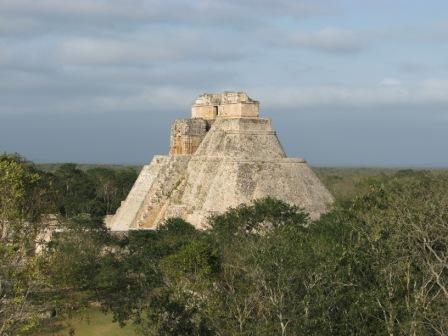Below are some of the major travel highlights for La Ruta Maya. For more in-depth attractions of each country on this route, click on the country names below or select a route to see the highlights on this section of the journey. Click on the icons below to focus on specific types of features (click again to return to all).
| In-depth highlights: Belize, Guatemala, Honduras, Mexico |
 | |||||||||||
|---|---|---|---|---|---|---|---|---|---|---|---|
| Natural | History | Wildlife | Trekking | Cities | Religious Monument | Boat Journey | Rail Journey | Diving | Cultural | Adrenaline | UNESCO WHS |
UNESCO World Heritage Sites of Western Mayan Peninsula
| Mayan City of Chichen-Itza | |
|---|---|
Chichen-Itza is one of the most extraordinary archaeological sites in the world and was recently named one of the new Seven Wonders of the World. It represents two major periods of pre-Hispanic Mesoamerican civilisations - a Mayan site from the Classical period between the 5th and 10th centuries and a second settlement after the Toltec invasion with major construction between the 10th and 13th centuries. The latter represented a fusion between Mayan and Toltec cultures and represents some of the most important monuments at Chichen-Itza. The most remarkable structure is the El Castillo or the Pyramid of Kulkulkan, a stone representation of the Mayan calendar. The 25 metre high pyramid has 365 steps and at equinox a shadow of the serpent is cast down the pyramid connecting their heads at the foot to their tails at the top. Surrounding El Castillo are the Great Ball Court, the Temple of the Warriors, the Group of the Thousand Columns and the Observatory. Chichen Itza is the most visited historical site in Mexico and can get very crowded but the wealth of its attractions make it an essential visit. UNESCO World Heritage Site: Pre-Hispanic City of Chichen-Itza | |
| Mayan City of Uxmal | |
|---|---|
The ruins at Uxmal represent the pinnacle of late-Mayan architecture, design and layout. The buildings here date from 700-1000 AD when Uxmal had approximately 25,000 inhabitants and their layout reveal a detailed knowledge of astronomy. The Piramide del Adivino dominates the site, a spectacular structure with many symbolic motifs and sculptures depicting Chaac, the god of rain. Other buildings of note include the Nunnery Quadrangle, Governor's Palace and the Great Pyramid, which can be climbed to get a superb panoramic views of the whole site. A nightly light and sound show speculates on the decline of the city due to drought with the residents appealing to Chaac to save them. Close to Uxmal are three smaller sites with their own unique features. The Palace of Masks at Kabah has 260 images of Chaac, the Gran Palacio at Sayil is an elegant three-storey structure while Labna has a rare arch connecting two groups of buildings. UNESCO World Heritage Site: Pre-Hispanic Town of Uxmal | |
| Historic Town of Campeche | |
|---|---|
Campeche is a harbour town located on the Gulf of Mexico coast of the Yucatan peninsula. Founded by the Spanish in the 16th century, it was surrounded by outer walls and fortifications to protect the town from attack from English and Dutch buccaneers and pirates. Many of these fortifications survive today, in addition to almost 1,000 buildings of historic value in the old town. These include the Cathedral of the Immaculate Conception, the Toro Theatre and the municipal archives but its the brightly coloured buildings and clean streets of the town that are its most attractive features. UNESCO World Heritage Site: Historic Fortified Town of Campeche | |
| Mayan City of Palenque | |
|---|---|
One of the most picturesque and impressive of all the Mayan sites, Palenque is one of Mexico's prime attractions. Several spectacular structures are set in a beautiful location deep in the rainforest of southern Mexico. Rediscovered in the 19th century, only a fraction of the site has been studied and excavated and its possible to walk through the jungle trees over the crumbling remains of other buildings and wonder what remains to be discovered. Palenque flourished as a Mayan city state for 600 years between the 4th and 10th centuries but reached it height during the reigns of Pakal and Chan-Bahlum in the 7th century when its most impressive buildings were constructed. Central to Palenque are the various buildings of the Palacio, built on an artificial mound, and including the four-storey renovated watchtower, unique in Mayan architecture. The Temple of the Inscriptions is perhaps the most impressive structure, a 25 metre high pyramid which contains inscriptions detailing Palenque's history and was the site where the burial tomb of Pakal and his jade death mask was found. Unfortunately its not permitted to climb the Temple, but the nearby Temple of the Cross can be climbed to give super panoramic vistas of the entire site. UNESCO World Heritage Site: Pre-Hispanic City and National Park of Palenque | |
| Antigua Guatemala | |
|---|---|
Antigua is one of the best preserved Spanish colonial towns in Latin America and a magnet for travellers to this region. Located in a spectacular setting underneath the Agua, Fuego and Acatenango volcanoes, it is a beautifully laid back town of Spanish Baroque buildings, ruined and preserved churches and many interesting cafes, restaurants and markets. Founded in 1543, Antigua was capital of the Spanish colonial empire in Central America for over two centuries until an earthquake in 1773 led to the relocation of the capital to Guatemala City. As well as exploring the historic buildings, streets and courtyards, Antigua is a prime location for learning Spanish, with over 30 language schools. Additionally, the nearby Pacaya volcano can be summited with a half-day hike, allowing you to get stand right next to red-hot lava flows and admire the view of nearby volcano cones. UNESCO World Heritage Site: Antigua Guatemala | |





